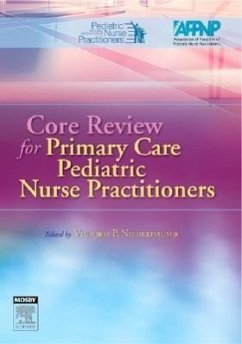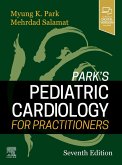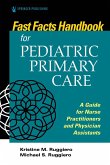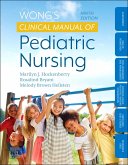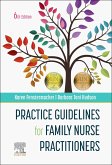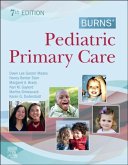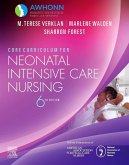National Association of Pediatric Nurse, Association of Faculties of Pediatric Nu
Core Review for Primary Care Pediatric Nurse Practitioners
Herausgeber: Niederhauser, Victoria Page
National Association of Pediatric Nurse, Association of Faculties of Pediatric Nu
Core Review for Primary Care Pediatric Nurse Practitioners
Herausgeber: Niederhauser, Victoria Page
- Broschiertes Buch
- Merkliste
- Auf die Merkliste
- Bewerten Bewerten
- Teilen
- Produkt teilen
- Produkterinnerung
- Produkterinnerung
Provides practice questions for graduates for both pediatric and family nurse practitioner programs to use in their respective certification exams offered by the PNCB and ANCC. This title covers review questions which include the Role of the PNP, Wellness Issues, Growth and Development, Genetics, Chronic Conditions, and, more.
Andere Kunden interessierten sich auch für
![Park's Pediatric Cardiology for Practitioners Park's Pediatric Cardiology for Practitioners]() Park, Myung K., MD, FAAP, FACC (Professor Emeritus (Pediatrics) ForPark's Pediatric Cardiology for Practitioners120,99 €
Park, Myung K., MD, FAAP, FACC (Professor Emeritus (Pediatrics) ForPark's Pediatric Cardiology for Practitioners120,99 €![Fast Facts Handbook for Pediatric Primary Care Fast Facts Handbook for Pediatric Primary Care]() Kristine M RuggieroFast Facts Handbook for Pediatric Primary Care42,99 €
Kristine M RuggieroFast Facts Handbook for Pediatric Primary Care42,99 €![Wong's Clinical Manual of Pediatric Nursing Wong's Clinical Manual of Pediatric Nursing]() Marilyn J. Hockenberry (Baylor College of Professor of PediatricsWong's Clinical Manual of Pediatric Nursing61,99 €
Marilyn J. Hockenberry (Baylor College of Professor of PediatricsWong's Clinical Manual of Pediatric Nursing61,99 €![Practice Guidelines for Family Nurse Practitioners Practice Guidelines for Family Nurse Practitioners]() Karen Fenstermacher (Family Nurse Practitioner, Mercy Primary Care,Practice Guidelines for Family Nurse Practitioners83,99 €
Karen Fenstermacher (Family Nurse Practitioner, Mercy Primary Care,Practice Guidelines for Family Nurse Practitioners83,99 €![Nursing Care of the Critically Ill Child Nursing Care of the Critically Ill Child]() Mary Fran Hazinski (Professor of NursingVanderbilt University SNursing Care of the Critically Ill Child83,99 €
Mary Fran Hazinski (Professor of NursingVanderbilt University SNursing Care of the Critically Ill Child83,99 €![Burns' Pediatric Primary Care Burns' Pediatric Primary Care]() Dawn Lee Garzon (St. Louis Children's Pediatric Nurse PractitionerBurns' Pediatric Primary Care166,99 €
Dawn Lee Garzon (St. Louis Children's Pediatric Nurse PractitionerBurns' Pediatric Primary Care166,99 €![Core Curriculum for Neonatal Intensive Care Nursing Core Curriculum for Neonatal Intensive Care Nursing]() AWHONNCore Curriculum for Neonatal Intensive Care Nursing119,99 €
AWHONNCore Curriculum for Neonatal Intensive Care Nursing119,99 €-
-
-
Provides practice questions for graduates for both pediatric and family nurse practitioner programs to use in their respective certification exams offered by the PNCB and ANCC. This title covers review questions which include the Role of the PNP, Wellness Issues, Growth and Development, Genetics, Chronic Conditions, and, more.
Hinweis: Dieser Artikel kann nur an eine deutsche Lieferadresse ausgeliefert werden.
Hinweis: Dieser Artikel kann nur an eine deutsche Lieferadresse ausgeliefert werden.
Produktdetails
- Produktdetails
- Verlag: Elsevier - Health Sciences Division
- Seitenzahl: 424
- Erscheinungstermin: 16. April 2007
- Englisch
- Abmessung: 259mm x 186mm x 17mm
- Gewicht: 978g
- ISBN-13: 9780323027571
- ISBN-10: 0323027571
- Artikelnr.: 21408852
- Verlag: Elsevier - Health Sciences Division
- Seitenzahl: 424
- Erscheinungstermin: 16. April 2007
- Englisch
- Abmessung: 259mm x 186mm x 17mm
- Gewicht: 978g
- ISBN-13: 9780323027571
- ISBN-10: 0323027571
- Artikelnr.: 21408852
Section 1: Role of the Pediatric Nurse Practitioner
1. Evolution of the Pediatric Nurse Practitioner Role
2. Essential Elements of the Advanced Practice Role for Pediatric Nurse
Practitioners
3. Clinical Reasoning and Clinical Decision Making
Section 2: Health Assessment and Physical Examination
4. Measures of Child Growth and Development
5. Assessment of the Head, Eyes, Ears, Nose and Throat
6. Assessment of the Pulmonary System
7. Assessment of the Cardiovascular System
8. Assessment of the Gastrointestinal System
9. Assessment of the Reproductive and Urologic Systems
10. Assessment of the Integumentary System
11. Assessment of the Hematologic and Lymphatic Systems
12. Assessment of the Musculoskeletal System
13. Assessment of the Neurologic System
Section 3: Special Topics in Health Promotion and Disease Prevention
14. Core Concepts in Genetics
15. Immunizations
16. Nutrition
17. Preconceptional and Prenatal Role
18. Care of the Newborn Before Hospital Discharge
19. Newborns and Infants
20. Preterm Infant Follow-up Care
21. Child Abuse and Neglect
22. Toddlers, Preschoolers, and School-agers
23. Mental Health Promotion and Mental Health Screening for Children and
Adolescents
24. Sports Participation: Evaluation and Monitoring
25. Early Adolescents, Late Adolescents, and College-age Young Adults
26. Sexuality and Birth Control
Section 4: Diagnosis and Management of Common Illness in Children and
Adolescents
27. Common Illness of the Head, Eyes, Ears, Nose and Throat
28. Common Illness of the Pulmonary System
29. Common Illness of the Cardiovascular System
30. Common Illness of the Gastrointestinal System
31. Common Illness of the Reproductive and Urologic Systems
32. Common Illness of the Integumentary System
33. Common Illness of the Hematologic and Lymphatic Systems
34. Common Illness of the Musculoskeletal System
35. Common Illness of the Neurologic System
Section 5: Diagnosis and Management of Chronic Conditions in Children and
Adolescents
36. Asthma
37. Cerebral Palsy
38. Childhood Cancer
39. Cleft Lip and Palate
40. Common Genetic Conditions in Children
41. Common Mental Health Disorders in Children and Adolescents
42. Congenital Heart Disease
43. Cystic Fibrosis
44. Diabetes Types 1 and 2
45. Eating Disorders
46. Epilepsy
47. Hemoglobinopathies
48. Juvenile Rheumatoid Arthritis
49. Learning Disorders and Attention Deficit Hyperactivity Disorder
50. Chronic Renal Failure in Children
51. Spina Bifida and Other Myelodysplasias
Section 6: Diagnostic, Medication, and Treatment Guides for Children and
Adolescents
52. Readiness for Handling Pediatric Emergencies in the Primary Care Office
53. Diagnostic Tests for Pediatric Clinical Decision Making
54. Pharmacodynamic Considerations Unique to Neonates, Infants, Children,
and Adolescents
55. Pain Management for Children
56. Complementary and Alternative Therapy
57. Nonpharmacologic Treatments and Pediatric Procedures
Section 7: Using Evidence-Based Practice to Improve Outcomes in Outpatient
Settings
58. Evolving Roles for Pediatric Nurse Practitioners
1. Evolution of the Pediatric Nurse Practitioner Role
2. Essential Elements of the Advanced Practice Role for Pediatric Nurse
Practitioners
3. Clinical Reasoning and Clinical Decision Making
Section 2: Health Assessment and Physical Examination
4. Measures of Child Growth and Development
5. Assessment of the Head, Eyes, Ears, Nose and Throat
6. Assessment of the Pulmonary System
7. Assessment of the Cardiovascular System
8. Assessment of the Gastrointestinal System
9. Assessment of the Reproductive and Urologic Systems
10. Assessment of the Integumentary System
11. Assessment of the Hematologic and Lymphatic Systems
12. Assessment of the Musculoskeletal System
13. Assessment of the Neurologic System
Section 3: Special Topics in Health Promotion and Disease Prevention
14. Core Concepts in Genetics
15. Immunizations
16. Nutrition
17. Preconceptional and Prenatal Role
18. Care of the Newborn Before Hospital Discharge
19. Newborns and Infants
20. Preterm Infant Follow-up Care
21. Child Abuse and Neglect
22. Toddlers, Preschoolers, and School-agers
23. Mental Health Promotion and Mental Health Screening for Children and
Adolescents
24. Sports Participation: Evaluation and Monitoring
25. Early Adolescents, Late Adolescents, and College-age Young Adults
26. Sexuality and Birth Control
Section 4: Diagnosis and Management of Common Illness in Children and
Adolescents
27. Common Illness of the Head, Eyes, Ears, Nose and Throat
28. Common Illness of the Pulmonary System
29. Common Illness of the Cardiovascular System
30. Common Illness of the Gastrointestinal System
31. Common Illness of the Reproductive and Urologic Systems
32. Common Illness of the Integumentary System
33. Common Illness of the Hematologic and Lymphatic Systems
34. Common Illness of the Musculoskeletal System
35. Common Illness of the Neurologic System
Section 5: Diagnosis and Management of Chronic Conditions in Children and
Adolescents
36. Asthma
37. Cerebral Palsy
38. Childhood Cancer
39. Cleft Lip and Palate
40. Common Genetic Conditions in Children
41. Common Mental Health Disorders in Children and Adolescents
42. Congenital Heart Disease
43. Cystic Fibrosis
44. Diabetes Types 1 and 2
45. Eating Disorders
46. Epilepsy
47. Hemoglobinopathies
48. Juvenile Rheumatoid Arthritis
49. Learning Disorders and Attention Deficit Hyperactivity Disorder
50. Chronic Renal Failure in Children
51. Spina Bifida and Other Myelodysplasias
Section 6: Diagnostic, Medication, and Treatment Guides for Children and
Adolescents
52. Readiness for Handling Pediatric Emergencies in the Primary Care Office
53. Diagnostic Tests for Pediatric Clinical Decision Making
54. Pharmacodynamic Considerations Unique to Neonates, Infants, Children,
and Adolescents
55. Pain Management for Children
56. Complementary and Alternative Therapy
57. Nonpharmacologic Treatments and Pediatric Procedures
Section 7: Using Evidence-Based Practice to Improve Outcomes in Outpatient
Settings
58. Evolving Roles for Pediatric Nurse Practitioners
Section 1: Role of the Pediatric Nurse Practitioner
1. Evolution of the Pediatric Nurse Practitioner Role
2. Essential Elements of the Advanced Practice Role for Pediatric Nurse
Practitioners
3. Clinical Reasoning and Clinical Decision Making
Section 2: Health Assessment and Physical Examination
4. Measures of Child Growth and Development
5. Assessment of the Head, Eyes, Ears, Nose and Throat
6. Assessment of the Pulmonary System
7. Assessment of the Cardiovascular System
8. Assessment of the Gastrointestinal System
9. Assessment of the Reproductive and Urologic Systems
10. Assessment of the Integumentary System
11. Assessment of the Hematologic and Lymphatic Systems
12. Assessment of the Musculoskeletal System
13. Assessment of the Neurologic System
Section 3: Special Topics in Health Promotion and Disease Prevention
14. Core Concepts in Genetics
15. Immunizations
16. Nutrition
17. Preconceptional and Prenatal Role
18. Care of the Newborn Before Hospital Discharge
19. Newborns and Infants
20. Preterm Infant Follow-up Care
21. Child Abuse and Neglect
22. Toddlers, Preschoolers, and School-agers
23. Mental Health Promotion and Mental Health Screening for Children and
Adolescents
24. Sports Participation: Evaluation and Monitoring
25. Early Adolescents, Late Adolescents, and College-age Young Adults
26. Sexuality and Birth Control
Section 4: Diagnosis and Management of Common Illness in Children and
Adolescents
27. Common Illness of the Head, Eyes, Ears, Nose and Throat
28. Common Illness of the Pulmonary System
29. Common Illness of the Cardiovascular System
30. Common Illness of the Gastrointestinal System
31. Common Illness of the Reproductive and Urologic Systems
32. Common Illness of the Integumentary System
33. Common Illness of the Hematologic and Lymphatic Systems
34. Common Illness of the Musculoskeletal System
35. Common Illness of the Neurologic System
Section 5: Diagnosis and Management of Chronic Conditions in Children and
Adolescents
36. Asthma
37. Cerebral Palsy
38. Childhood Cancer
39. Cleft Lip and Palate
40. Common Genetic Conditions in Children
41. Common Mental Health Disorders in Children and Adolescents
42. Congenital Heart Disease
43. Cystic Fibrosis
44. Diabetes Types 1 and 2
45. Eating Disorders
46. Epilepsy
47. Hemoglobinopathies
48. Juvenile Rheumatoid Arthritis
49. Learning Disorders and Attention Deficit Hyperactivity Disorder
50. Chronic Renal Failure in Children
51. Spina Bifida and Other Myelodysplasias
Section 6: Diagnostic, Medication, and Treatment Guides for Children and
Adolescents
52. Readiness for Handling Pediatric Emergencies in the Primary Care Office
53. Diagnostic Tests for Pediatric Clinical Decision Making
54. Pharmacodynamic Considerations Unique to Neonates, Infants, Children,
and Adolescents
55. Pain Management for Children
56. Complementary and Alternative Therapy
57. Nonpharmacologic Treatments and Pediatric Procedures
Section 7: Using Evidence-Based Practice to Improve Outcomes in Outpatient
Settings
58. Evolving Roles for Pediatric Nurse Practitioners
1. Evolution of the Pediatric Nurse Practitioner Role
2. Essential Elements of the Advanced Practice Role for Pediatric Nurse
Practitioners
3. Clinical Reasoning and Clinical Decision Making
Section 2: Health Assessment and Physical Examination
4. Measures of Child Growth and Development
5. Assessment of the Head, Eyes, Ears, Nose and Throat
6. Assessment of the Pulmonary System
7. Assessment of the Cardiovascular System
8. Assessment of the Gastrointestinal System
9. Assessment of the Reproductive and Urologic Systems
10. Assessment of the Integumentary System
11. Assessment of the Hematologic and Lymphatic Systems
12. Assessment of the Musculoskeletal System
13. Assessment of the Neurologic System
Section 3: Special Topics in Health Promotion and Disease Prevention
14. Core Concepts in Genetics
15. Immunizations
16. Nutrition
17. Preconceptional and Prenatal Role
18. Care of the Newborn Before Hospital Discharge
19. Newborns and Infants
20. Preterm Infant Follow-up Care
21. Child Abuse and Neglect
22. Toddlers, Preschoolers, and School-agers
23. Mental Health Promotion and Mental Health Screening for Children and
Adolescents
24. Sports Participation: Evaluation and Monitoring
25. Early Adolescents, Late Adolescents, and College-age Young Adults
26. Sexuality and Birth Control
Section 4: Diagnosis and Management of Common Illness in Children and
Adolescents
27. Common Illness of the Head, Eyes, Ears, Nose and Throat
28. Common Illness of the Pulmonary System
29. Common Illness of the Cardiovascular System
30. Common Illness of the Gastrointestinal System
31. Common Illness of the Reproductive and Urologic Systems
32. Common Illness of the Integumentary System
33. Common Illness of the Hematologic and Lymphatic Systems
34. Common Illness of the Musculoskeletal System
35. Common Illness of the Neurologic System
Section 5: Diagnosis and Management of Chronic Conditions in Children and
Adolescents
36. Asthma
37. Cerebral Palsy
38. Childhood Cancer
39. Cleft Lip and Palate
40. Common Genetic Conditions in Children
41. Common Mental Health Disorders in Children and Adolescents
42. Congenital Heart Disease
43. Cystic Fibrosis
44. Diabetes Types 1 and 2
45. Eating Disorders
46. Epilepsy
47. Hemoglobinopathies
48. Juvenile Rheumatoid Arthritis
49. Learning Disorders and Attention Deficit Hyperactivity Disorder
50. Chronic Renal Failure in Children
51. Spina Bifida and Other Myelodysplasias
Section 6: Diagnostic, Medication, and Treatment Guides for Children and
Adolescents
52. Readiness for Handling Pediatric Emergencies in the Primary Care Office
53. Diagnostic Tests for Pediatric Clinical Decision Making
54. Pharmacodynamic Considerations Unique to Neonates, Infants, Children,
and Adolescents
55. Pain Management for Children
56. Complementary and Alternative Therapy
57. Nonpharmacologic Treatments and Pediatric Procedures
Section 7: Using Evidence-Based Practice to Improve Outcomes in Outpatient
Settings
58. Evolving Roles for Pediatric Nurse Practitioners
